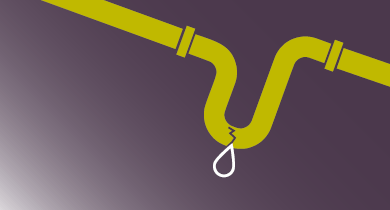Troubled waters – how to cope with leaks


As practices struggle to return to some semblance of normality post lockdown, the enforced closure of many practices may well have caused unforeseen issues in terms of building maintenance and possible pipe deterioration whilst left unattended.
Whilst your priority continues to be the safety of your staff and patients, unfortunately your practice building demands more than just daily cleaning protocols. You still need to maintain the security of the building, comply with statutory requirements and review your insurance cover.
One issue that is prevalent within dental practices, even before they were recommissioned after closure, is the peril known as ‘escape of water’ or EOW. We’re talking internally burst pipes, water damage and expensive repairs, not to mention the disruption to patient care.
Chartered Institute for Plumbing and Heating Engineering (CIPHE) in the UK has also shared its concerns around the rising numbers of water damage incidents.* As buildings slowly become reoccupied post-lockdown, there’s an increased risk of water damage as systems that have not been used for some time are suddenly turned on and re-activated, which may potentially result in pressure surges leading to joint and system failures. The institute advises that extra caution is taken, particularly in areas containing high value equipment.
Several factors contribute to the frequency and severity of the issue, including bad building design, poor quality of materials, surgery improvements or extensions. These can put extra demands on existing plumbing. Other factors include poor workmanship, corrosion, blocked outlet pipes, physical damage and the age and state of repair of your buildings, to name but a few. Obviously practices’ being left vacant for weeks on end has not helped either.
Dental practices have large volumes of water pumping through their surgeries compared to other commercial buildings. Add to that frozen pipes in winter, pressure fluctuations or ground subsidence and it’s clear that water leaks are a potential disaster waiting to happen.
Insurers pay out a massive £930 million in water-related claims each year and, while other commercial property claims have declined in recent years, according to data from the Association of British Insurers (ABI), escape of water claims have been steadily rising over the past 15 years*,
Even seemingly small leaks can cause significant problems for property owners, with the tiniest of ruptures potentially releasing large amounts of water, damaging plaster, flooring and other contents.
The ABI state that a claim relating to a burst pipe costs nearly £9,000 on average*, as often cost of repairs extends far beyond the actual pipe. They state that members pay out approximately £2.5 million every day on escape of water claims.
EOW claims account for approximately 25% of all practice claims through financial specialists Lloyd & Whyte with an average pay-out of over £5,000 and average costs are increasing.
Lloyd & Whyte have seen the number of escape of water claims from practices rise by 80% and claims value increase by 35% during lockdown*
Clearly it’s a big problem, but help is at hand. Escape of water is not just a winter or post-lockdown phenomenon. It can happen at any time of year so there are steps you should take all year round to help mitigate risks to your practice.
Common types of leak can be prevented by the following:-
Like good dentistry, prevention and early detection is vital. Fortunately, modern technology is also (literally) on hand to provide early warning solutions via detection software systems. Controlled via your smart phone app, they can mitigate damage by allowing you to shut off the water supply remotely.
These easy to install so called IoT (Internet of Things) devices like SureStop, Waterlock or LeakSafe WaterSwitch2, LeakBot, sensors are actively encouraged by insurers. So much so that in the dental practice policy provided by Lloyd & Whyte, the excess is reduced to £0 for claims where a water shut-off device is installed and in use.

We work with a company called Surestop who offer a unique and innovative Stopcock range, focused around protecting properties from the risk of water damage. With a simple flick of a switch, Surestop Stopcocks will completely STOP the water supply – without the use of batteries or electrics. Surestop is easier and quicker to install and use over traditional brass stopcocks and are available with a discreet and modern control.
At Lloyd & Whyte, we’ll provide you with a standard (non IoT) water shut device free of charge if you have a dental practice insurance policy with us. You only need to pay for installation. Plus you can benefit from a £0 excess on any claims and a reduction in your premiums where a water shut-off device is installed and in use***.
For further advice from Lloyd &Whyte on how to reduce escape of water claims look online
There are a number of companies that can provide property damage control advice and they can help you put together a risk management strategy to prevent escape of water issues.
https://www.robertpearson.co.uk/
https://www.waterguard.co.uk/
https://www.techhive.com/
https://www.envirotechalarms.com/
https://www.aqualeak.com/
https://www.polygongroup.com/en-GB/
For more information on how Lloyd &Whyte can protect you and your practice go to our article here
*ABI- report 2018
** Claims made April-June 2020 Vs same period in 2019
*** Proof of water shut being used at the point of claim
This advice has been written with all available knowledge, expertise and guidance from relevant authorities and insurers at the time of publication.
You can also keep up to date by following us on social media.